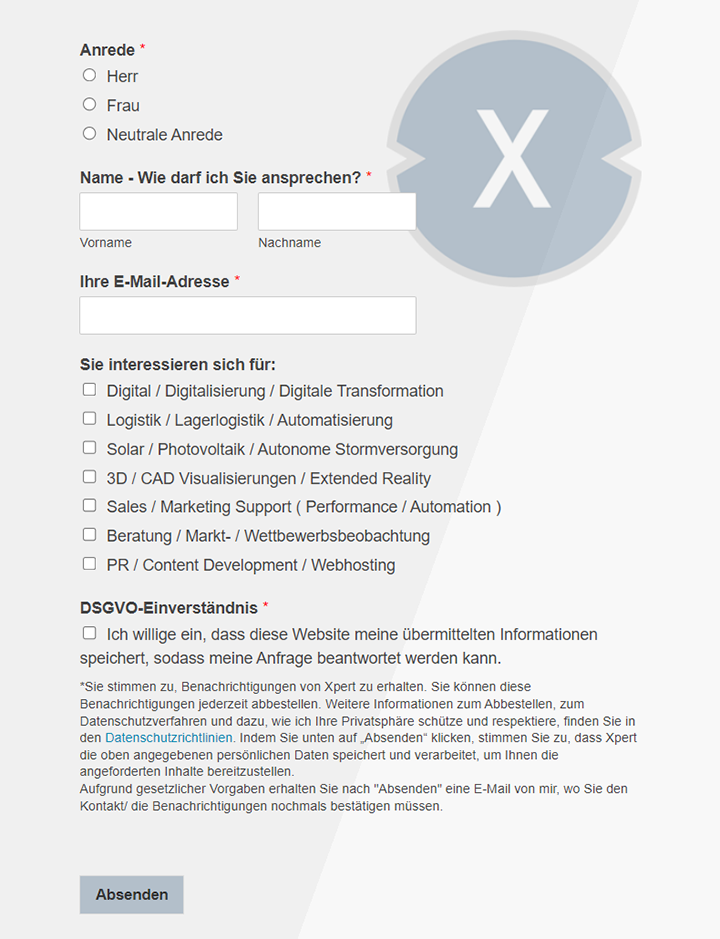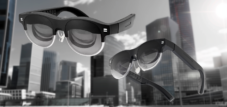Forget your monitor – the perfect video glasses? The RayNeo Air 3s Pro is your 201-inch cinema panorama for just 76 grams.
Xpert pre-release
Language selection 📢
Published on: August 29, 2025 / Updated on: August 29, 2025 – Author: Konrad Wolfenstein
Discreet sound, huge picture: The secret of the RayNeo Air 3s Pro and its “Whisper Mode”
What is the RayNeo Air 3s Pro and what makes it special?
The RayNeo Air 3s Pro are state-of-the-art video glasses featuring innovative tandem OLED display technology. These glasses belong to the latest generation of AR glasses and are particularly notable for their extreme brightness of 1,200 nits, making them among the brightest AR glasses available on the market. What makes these video glasses special is their ability to simulate a virtual screen with a diagonal of 201 inches, as if viewing a giant TV from a distance of six meters.
The glasses deliberately forgo an integrated processor or battery, focusing instead on pure image reproduction. This keeps them exceptionally light at just 76 grams while remaining versatile, as they are compatible with a wide range of devices. This design philosophy makes them a pure display device, leveraging its strengths in image quality and comfort.
Suitable for:
- Rayneo reveals the latest XR glasses Rayneo Air 3S on the MWC 2025-a sound miracle, eye-friendly and immersive
How does the tandem OLED technology work in the RayNeo Air 3s Pro?
Tandem OLED technology is an advanced evolution of conventional OLED displays and represents a significant technological advance. This technology utilizes two stacked organic RGB light emitting layers, unlike the single-layer OLED displays used in many other devices. This dual-layer structure enables significantly higher brightness while improving energy efficiency and extending the display's lifespan.
In the RayNeo Air 3s Pro, this technology is implemented in the form of two tandem Micro-OLED panels capable of achieving an impressive brightness of 1,200 nits. This extreme brightness is especially important for AR glasses, as it ensures the display remains clearly visible even in bright ambient light. The tandem structure also provides improved edge sharpness and an impressive contrast ratio of 200,000:1.
Technical specifications and display quality
What display features does the RayNeo Air 3s Pro offer?
The RayNeo Air 3s Pro is equipped with state-of-the-art Micro-OLED panels manufactured according to the HueView 2.0 standard. These displays offer a resolution of 1920 x 1080 pixels per eye and support a refresh rate of 120 Hz, ensuring smooth motion and a stutter-free display. The display covers 98 percent of the DCI-P3 color space, enabling exceptionally realistic and vibrant color reproduction.
A particularly important aspect of the display's quality is the 200,000:1 contrast ratio, enabled by OLED technology. This means that black areas are displayed as truly black, while bright areas can shine brilliantly. Color accuracy is rated at a Delta E value of less than 2, which meets professional standards and guarantees highly precise color reproduction.
How do I adjust the brightness of the RayNeo Air 3s Pro?
The RayNeo Air 3s Pro's brightness control is achieved via a sophisticated system with 20 different brightness levels. This fine gradation allows users to precisely adjust the screen brightness to different lighting conditions. The glasses use a PWM frequency of 3,840 Hz to prevent visible flickering. This high frequency is particularly important for eye protection, as lower PWM frequencies can cause headaches and eye strain in sensitive individuals.
The use of a 3,840 Hz PWM frequency is well above the range at which the human eye can perceive flickering. While sensitive users may still notice flickering at frequencies below 500 Hz, the RayNeo Air 3s Pro, with its high frequency, offers comfortable and eye-friendly operation. Additionally, the glasses are TÜV SÜD certified and offer both low blue light and a flicker-free display.
What does the DCI-P3 color space mean for image quality?
The DCI-P3 color space is an industry standard originally developed for digital cinema productions, offering a significantly expanded color gamut compared to the conventional sRGB color space. The RayNeo Air 3s Pro covers 98 percent of the DCI-P3 color space, meaning it can display virtually the entire spectrum of colors used in professional film productions. This is especially important for realistic and vibrant color reproduction that matches what filmmakers and content creators originally intended.
The DCI-P3 color space encompasses approximately 25 percent more colors than the sRGB standard and offers a significantly expanded palette, especially in red and green tones. This results in more natural skin tones, more vibrant landscape shots, and overall more realistic color reproduction. For users, this means that movies, games, and other content are displayed as they were originally intended, with the full color depth and brilliance that modern production standards allow.
Suitable for:
Audio technology and sound quality
How does the RayNeo Air 3s Pro audio system work?
The RayNeo Air 3s Pro features a sophisticated audio system with a total of four speakers housed in the temples. This configuration creates a spatial sound that creates the impression that the sound is coming from different directions. The system uses proprietary spatial audio technology that adapts the sound to the wearer's head movements.
The speakers are designed according to the Dual Opposing Acoustic Chamber principle, which ensures particularly balanced sound reproduction. This technology creates a cinema-like surround sound effect, even though the speakers are located directly at the ears. The sound is directed so that it is primarily audible to the wearer, while the surroundings are minimally affected by the audio.
What is Whisper Mode and how does it work?
Whisper Mode is a special audio technology on the RayNeo Air 3s Pro designed to protect the user's privacy in public environments. This feature uses advanced phase-cancelling technology to prevent the sound emitted by the speakers from being heard by people in the immediate vicinity. It directs and modulates the sound to primarily reach the wearer's ears while minimizing sound propagation to the outside.
Whisper technology utilizes various acoustic principles, including beamforming and phase cancellation. Beamforming directs sound precisely toward the wearer's ears, while phase cancellation ensures that sound waves that could propagate in other directions are neutralized with anti-phase signals. This allows users to enjoy private audio without disturbing others, even in busy environments like public transportation or cafes.
Compatibility and connectivity options
Which devices is the RayNeo Air 3s Pro compatible with?
The RayNeo Air 3s Pro boasts exceptionally broad device compatibility, encompassing over 1,000 different devices. The primary connection is via USB-C with DisplayPort support, making the glasses compatible with modern smartphones, tablets, laptops, and game consoles. Supported devices include Android smartphones and iPhones (with an appropriate adapter), MacBooks, Windows laptops, and game consoles such as the PlayStation 5 and Xbox systems via HDMI adapters.
Particularly interesting is the compatibility with portable gaming devices such as the Steam Deck, the ROG Ally, and, of course, the Nintendo Switch and the upcoming Nintendo Switch 2. For the Nintendo Switch systems, RayNeo offers special accessories such as the JoyDock, which enables seamless integration and also functions as a power bank. This broad compatibility makes the glasses a versatile display device that can be used with virtually any modern electronic device.
How does the connection work with the Nintendo Switch 2?
The RayNeo Air 3s Pro is already prepared for compatibility with the upcoming Nintendo Switch 2, even though that console isn't officially available yet. Connection is made via RayNeo's special JoyDock accessory, which acts as an intermediary between the console and the headset. This dock must be purchased separately and offers additional features beyond signal transmission.
The JoyDock features a built-in 10,000 mAh power bank that can power both the Nintendo Switch and the AR glasses. This significantly extends playtime and eliminates the problem of limited battery life during mobile gaming sessions. The dock also supports the simultaneous connection of two RayNeo glasses, enabling cooperative gaming or shared multimedia experiences. The connection is made via a single cable, simplifying handling and eliminating cable clutter.
What additional adapters and accessories are required?
For full functionality of the RayNeo Air 3s Pro with various devices, several additional adapters and accessories are required, which must be purchased separately. Connecting to HDMI-based devices such as game consoles or older laptops requires an HDMI-to-USB-C adapter. This adapter converts the HDMI signal to a DisplayPort signal that the glasses can process.
For optimal use with the Nintendo Switch or Switch 2, the aforementioned JoyDock is recommended. It not only enables signal transmission but also functions as a charging station and power bank. iPhone users require a special USB-C to Lightning adapter or a USB-C to USB-C adapter, depending on the iPhone model. RayNeo also offers additional accessories such as carrying cases, additional nose pads for different face shapes, and a frame for prescription glasses.
🗒️ Xpert.Digital: A pioneer in the field of extended and augmented reality
AR glasses of the future: Lightweight, smart, and multifunctional
Design and comfort
How is the RayNeo Air 3s Pro designed and how comfortable is it to wear?
The RayNeo Air 3s Pro was developed with a special focus on comfort and everyday design. Weighing just 76 grams, it is one of the lightest AR glasses in its class. The weight is optimally distributed, with a 46.7 percent to 53.3 percent weight ratio between the front and back sections, ensuring a balanced distribution of the load on the nose and ears.
The design is visually inspired by conventional sunglasses, with the Pro version featuring a uniform matte black finish that appears more elegant and discreet than older models with silver accents. The glasses feature a FlexiFit hinge system and adjustable temples with nine different adjustment levels. Additionally, the nose pads are adjustable to three levels, allowing the glasses to adapt to different face shapes and are suitable for 93 percent of all users without constant readjustment.
Suitable for:
What adjustment options do the glasses offer for different users?
The RayNeo Air 3s Pro offers extensive adjustment options to accommodate different face shapes and visual needs. The temples are adjustable to nine different levels, allowing for precise adjustment to individual head sizes. The nose pads can be adjusted to three different levels, and additional nose pads in various sizes are included to ensure an optimal fit.
A particularly important aspect is compatibility with prescription glasses. The RayNeo Air 3s Pro comes with a frame for prescription lenses, allowing users with visual impairments to use the glasses without restrictions. The large 14 x 7 mm eyebox ensures that even users with different eye distances get a clear image. This eyebox is the area where the eye needs to be to see the entire image clearly, and the generous dimensions of the RayNeo Air 3s Pro make it comfortable for most users.
Areas of application and usage scenarios
For which applications is the RayNeo Air 3s Pro particularly suitable?
The RayNeo Air 3s Pro is designed for a wide range of application scenarios, with gaming and multimedia consumption taking center stage. The headset offers unique advantages, especially for gaming, as it creates a huge virtual screen that significantly intensifies the gaming experience. The 120 Hz refresh rate makes it particularly suitable for fast-paced games where smooth motion is critical. A special Game Mode optimizes contrast and color reproduction for gaming applications, ensuring that all details remain visible even in dark scenes.
For multimedia consumption, the glasses transform any compatible device into a personal home theater. Whether streaming movies and series, watching YouTube videos, or viewing photos – the 201-inch virtual screen provides an immersive experience that conventional smartphone or tablet displays can't offer. The high color accuracy and excellent contrast ratio also make the glasses attractive for professional applications such as photo and video editing, especially for users who need to work on the go.
How can the glasses be used for mobile gaming?
The RayNeo Air 3s Pro opens up entirely new possibilities for mobile gaming by eliminating the limitations of small screens. When used with the Nintendo Switch or other portable consoles, it transforms the gaming experience from a small handheld display into a large-format, cinematic experience. The virtual 201-inch screen allows you to experience games with a level of detail and immersion not possible on conventional mobile displays.
The JoyDock is particularly advantageous, as it not only establishes the technical connection but also significantly extends battery life. The JoyDock's 10,000 mAh power bank can power both the console and the headset for hours, enabling extended gaming sessions. The headset's 120 Hz refresh rate ensures smooth motion, which is especially important for action games and fast-paced gameplay. Game Mode further optimizes the display for gaming content and enhances contrast, ensuring all details remain visible even in dark areas.
What benefits do the glasses offer for entertainment and productivity?
For entertainment applications, the RayNeo Air 3s Pro offers the advantage of a completely private and portable cinema experience. The 201-inch virtual screen creates the feeling of sitting in front of a giant TV while actually wearing lightweight, unobtrusive glasses. This allows you to enjoy a large-format entertainment experience even in cramped spaces such as airplanes, trains, or small apartments. The high picture quality with 98 percent DCI-P3 color coverage ensures that films and series are reproduced in the color quality intended by the director.
In terms of productivity, the glasses can serve as a large, additional monitor for laptops and tablets. The high resolution and color accuracy make them suitable for tasks such as photo and video editing, graphic design, or simply working with multiple windows on a virtually enlarged desktop. Whisper Mode enables discreet video conferencing or playing audio content without disturbing others. For presentations or training sessions, the glasses offer the ability to display content on a large virtual screen without relying on a physical projector.
Comparison with other AR glasses and market positioning
How does the RayNeo Air 3s Pro position itself in the AR glasses market?
The RayNeo Air 3s Pro positions itself as one of the brightest and most technologically advanced AR glasses in the mid-price segment in 2025. With its 1,200 nits of brightness, it significantly surpasses many competitors and sets new standards in this category. Compared to other AR glasses like the Xreal One Pro, which retails for $798, the RayNeo Air 3s Pro offers exceptional value at $249.99.
The market for AR glasses has diversified significantly in 2025, with offerings from various manufacturers such as Meta, Xreal, Viture, and others. The RayNeo Air 3s Pro differs from many competing products in its focus on pure display functionality, without integrated computing or complex AR features. This specialization allows for higher image quality and longer usability at a lower price, but makes it dependent on external devices for content generation.
What distinguishes the RayNeo Air 3s Pro from the standard Air 3s?
The RayNeo Air 3s Pro differs from the standard Air 3s version in several key areas, the most significant being brightness. While the standard Air 3s offers 650 nits of brightness, the Pro version achieves an impressive 1,200 nits, nearly doubling the brightness. This increased brightness has a noticeable effect when used in bright environments, providing better visibility in sunlight or well-lit rooms.
Another key difference lies in the display engine used. The Pro version uses the HueView 2.0 Micro-OLED engine with a tandem OLED structure, which is not only brighter but also offers improved edge definition and a higher contrast ratio. The audio system has also been redesigned, offering improved spatial sound reproduction with a better stereo effect and more precise positioning. Interestingly, despite these improvements, the Pro version is cheaper than the original Air 3s at launch, making it an attractive upgrade.
How do the glasses compare to traditional VR headsets?
Compared to traditional VR headsets, the RayNeo Air 3s Pro occupies a completely different market position, focusing on AR and display features rather than creating a fully virtual environment. While VR headsets like the Meta Quest or PlayStation VR create entire virtual worlds and feature integrated computers, sensors, and tracking systems, the RayNeo Air 3s Pro is a pure display device that displays content from external devices.
The advantages of the RayNeo Air 3s Pro over VR headsets lie primarily in its weight, portability, and versatility. At 76 grams, it is considerably lighter than most VR headsets, which often weigh 500-800 grams, and can therefore be worn comfortably for extended periods. It requires no complex room setup or tracking systems and can be used anywhere a compatible device is available. On the other hand, it does not offer the full immersion and interactive capabilities of VR headsets and is not suitable for true VR applications, as demonstrated by its incompatibility with Nintendo Labo VR games.
Our recommendation: 🌍 Limitless reach 🔗 Networked 🌐 Multilingual 💪 Strong sales: 💡 Authentic with strategy 🚀 Innovation meets 🧠 Intuition
At a time when a company's digital presence determines its success, the challenge is how to make this presence authentic, individual and far-reaching. Xpert.Digital offers an innovative solution that positions itself as an intersection between an industry hub, a blog and a brand ambassador. It combines the advantages of communication and sales channels in a single platform and enables publication in 18 different languages. The cooperation with partner portals and the possibility of publishing articles on Google News and a press distribution list with around 8,000 journalists and readers maximize the reach and visibility of the content. This represents an essential factor in external sales & marketing (SMarketing).
More about it here:
Future of Visibility: How Tandem OLED and AR Glasses are Changing Our Technology Landscape
Technical innovation and future orientation
What role does tandem OLED technology play in the future of display development?
The tandem OLED technology used in the RayNeo Air 3s Pro represents a significant step in display evolution and is expected to play an increasingly important role in various device categories. This technology is already used in premium products such as Apple's iPad Pro and is expected to make its way into other product categories such as smartphones and televisions in the coming years. The advantages of tandem OLED—higher brightness, better energy efficiency, and longer lifespan—make it particularly attractive for portable devices and applications where image quality is critical.
In the display industry, leading manufacturers such as LG Display and Samsung Display are already working on the next generation of OLED technologies based on the tandem principle. LG Display has announced that its new 4th-generation OLED panels for televisions can achieve up to 4,000 nits using an RGB tandem structure. Samsung Display is even developing OLED panels with up to 5,000 nits of brightness for smartphone applications. These developments demonstrate that tandem OLED technology is not just a temporary innovation, but a fundamental building block for the next generation of displays.
Suitable for:
- TCL Rayneo X3 Pro-Smart Glasses 2.0, Augmented Reality, AI glasses and more than just data glasses-Design & Display technology in the eye
How is the market for AR glasses and video glasses developing?
The market for AR and video glasses will experience a phase of rapid growth and technological maturation in 2025. Various manufacturers are continuously launching new models that differ in functionality, price, and intended use. While earlier AR glasses were often experimental in nature, current models are increasingly suitable for everyday use and are gaining broader acceptance among consumers.
Developments are moving in several directions: On the one hand, there are video glasses like the RayNeo Air 3s Pro, which focus on pure display functionality and function as external monitors. On the other hand, "true" AR glasses are being developed, equipped with cameras, AI functions, and interactive elements. Companies like Meta, Rokid, and others are working on glasses with built-in cameras, voice assistants, and AR overlays that overlay digital information into the real world. The market is thus increasingly differentiating between simpler, cheaper display glasses and more complex, more expensive AR systems with comprehensive functionality.
What technological improvements can be expected in future versions?
Future versions of AR glasses like the RayNeo Air series are expected to benefit from several technological developments already in the pipeline of the display and semiconductor industries. Tandem OLED technology will continue to be refined, with even higher brightness and improved energy efficiency expected. LG Display and other manufacturers are already working on Micro-OLED displays with up to 10,000 nits of brightness for VR and AR applications, which would significantly improve outdoor usability.
PWM frequencies are expected to be further increased to minimize eye strain, while color accuracy will be improved through expanded color spaces such as BT.2020. In the audio area, improvements to whisper technology and spatial sound reproduction are expected, potentially with even more precise directional control and better noise cancellation. Miniaturization will continue to advance, potentially leading to even lighter glasses with longer battery life for external devices. Additionally, improved connectivity options are expected, possibly with wireless transmission and improved compatibility with an even wider range of devices.
Practical use and suitability for everyday use
How long can the RayNeo Air 3s Pro be used continuously?
The continuous usage time of the RayNeo Air 3s Pro depends primarily on the battery capacity of the connected device, as the glasses themselves do not have a built-in battery. The glasses draw their power directly from the connected device via the USB-C connection, meaning the usage time correlates directly with the battery life of the smartphone, tablet, or game console. When used with the recommended JoyDock accessory for gaming applications, the usage time is significantly extended, as the dock features a 10,000 mAh power bank.
In terms of comfort, the RayNeo Air 3s Pro, with its low weight of just 76 grams, is designed for longer sessions. The balanced weight distribution and adjustable temples and nose pads allow many users to wear the glasses for several hours at a time without experiencing significant discomfort. The TÜV-certified eye protection with reduced blue light and high PWM frequency also helps ensure that even longer periods of use don't place excessive strain on the eyes.
What limitations are there in practical use?
One of the main limitations of the RayNeo Air 3s Pro is its dependence on external devices. Since the glasses have neither their own processor nor a battery, they are entirely dependent on a connected device to provide both content and power. This means the glasses cannot be used independently and always require a compatible device with sufficient battery capacity.
The glasses also allow ambient light to enter from below, which can impair the visibility of the virtual screen in very bright environments, although the high brightness of 1,200 nits largely compensates for this. For optimal results in very bright environments, separate accessories such as a light shield are required. Another practical aspect is that various adapters and accessories for use with different devices must be purchased separately, which adds cost and complexity.
How suitable is the RayNeo Air 3s Pro for mobile use?
The RayNeo Air 3s Pro is perfectly designed for mobile use, which is reflected in several design decisions. Their low weight of 76 grams and compact size make them an ideal travel companion. The glasses come with a storage case, which, while the Pro version is a soft fabric pouch and lacks the textured rigidity of the original Air 3s, still offers a certain degree of protection during transport.
The glasses are particularly well-suited for mobile gaming, transforming portable consoles like the Nintendo Switch, Steam Deck, or ROG Ally into large, immersive displays. Plug-and-play functionality via USB-C makes setup quick and easy, with no complicated configurations or software installations required. The high brightness of 1,200 nits also allows for use in a variety of lighting conditions, from dim interiors to brightly lit environments. For frequent travelers, the glasses offer the opportunity to enjoy a large-format entertainment or productivity experience even in cramped spaces such as airplane seats, without disturbing other passengers.
Suitable for:
- Xpert study on “The Market for Smart Glasses” - Analysis of market penetration, competition and future trends
AR glasses: Technological revolution between gaming, education and industry transformation
What developments can be expected in the AR glasses segment in the coming years?
The AR glasses segment is facing a phase of rapid technological evolution, characterized by several parallel development strands. One of the most important trends is further miniaturization and weight reduction, with manufacturers working to make the glasses even more discreet and suitable for everyday use. At the same time, the integration of AI functions will progress, with glasses capable of object recognition, text translation, calorie counting, and complex augmented reality overlays.
Display technology will continue to improve, with even higher brightness, better color accuracy, and higher resolutions expected. Micro-OLED displays with 10,000 nits or more are expected to become available in the next few years, which would make AR glasses perfectly usable even in direct sunlight. At the same time, companies are working on solving the power supply issue, possibly through more efficient displays, better battery technologies, or even wireless power transmission.
How will compatibility with gaming systems develop?
The compatibility of AR glasses with gaming systems is expected to improve significantly and become standardized. The Nintendo Switch 2 marks an important milestone, as it was designed with AR glasses compatibility in mind. Future consoles and gaming handhelds will likely support DisplayPort over USB-C as standard, reducing the need for special adapters.
The gaming industry is increasingly recognizing the potential of AR headsets for immersive gaming experiences, especially for mobile and handheld gaming. This could lead to games specifically optimized for AR headsets or game modes that leverage the unique advantages of large virtual displays. Manufacturers like RayNeo are already working on improved gaming accessories like the JoyDock, and similar solutions are likely to be developed by other vendors. Integration could go so far that future gaming systems offer native AR headset support without additional hardware.
What impact could the technology have on various industries?
The technologies used in the RayNeo Air 3s Pro, particularly the tandem OLED displays and advanced audio systems, have the potential to transform various industries. In the education sector, AR glasses could enable immersive learning experiences where complex concepts can be visually presented and explored interactively. The high color accuracy and large virtual display also make such glasses interesting for professional applications in design, architecture, and engineering.
In healthcare, doctors and therapists could use AR glasses for visualizations, remote consultations, or even surgical support. Whisper's technology would protect patient privacy. In the entertainment industry, AR glasses enable new forms of storytelling and content creation while providing personalized media experiences independent of physical screens. The transportation industry could use AR glasses for entertainment systems on airplanes, trains, and other modes of transport, giving each passenger a personalized, large-format display without the need for physical screens.
We are there for you - advice - planning - implementation - project management
☑️ SME support in strategy, consulting, planning and implementation
☑️ Creation or realignment of the AI strategy
☑️ Pioneer Business Development
I would be happy to serve as your personal advisor.
You can contact me by filling out the contact form below or simply call me on +49 89 89 674 804 (Munich) .
I'm looking forward to our joint project.
Xpert.Digital - Konrad Wolfenstein
Xpert.Digital is a hub for industry with a focus on digitalization, mechanical engineering, logistics/intralogistics and photovoltaics.
With our 360° business development solution, we support well-known companies from new business to after sales.
Market intelligence, smarketing, marketing automation, content development, PR, mail campaigns, personalized social media and lead nurturing are part of our digital tools.
You can find out more at: www.xpert.digital - www.xpert.solar - www.xpert.plus































